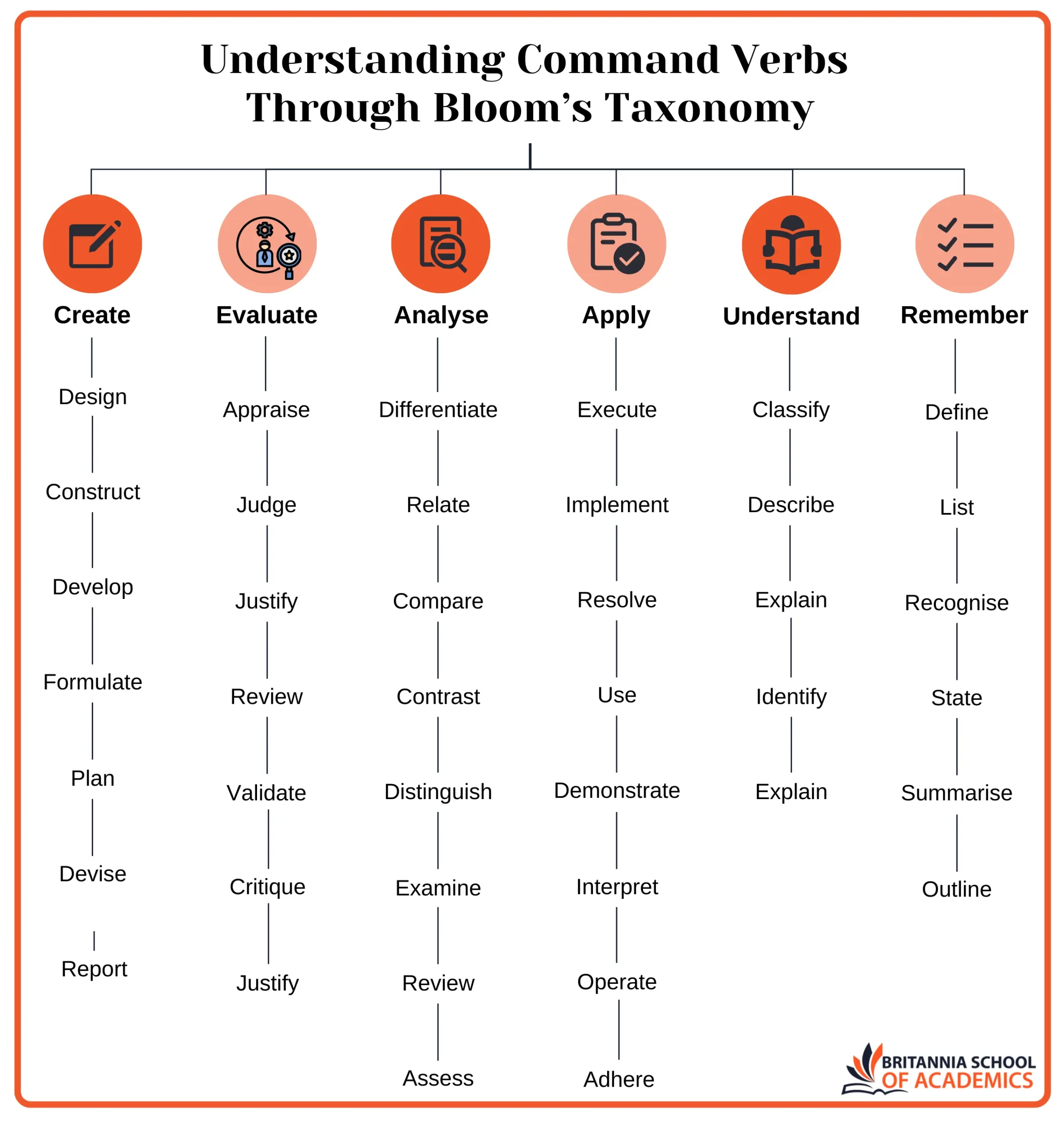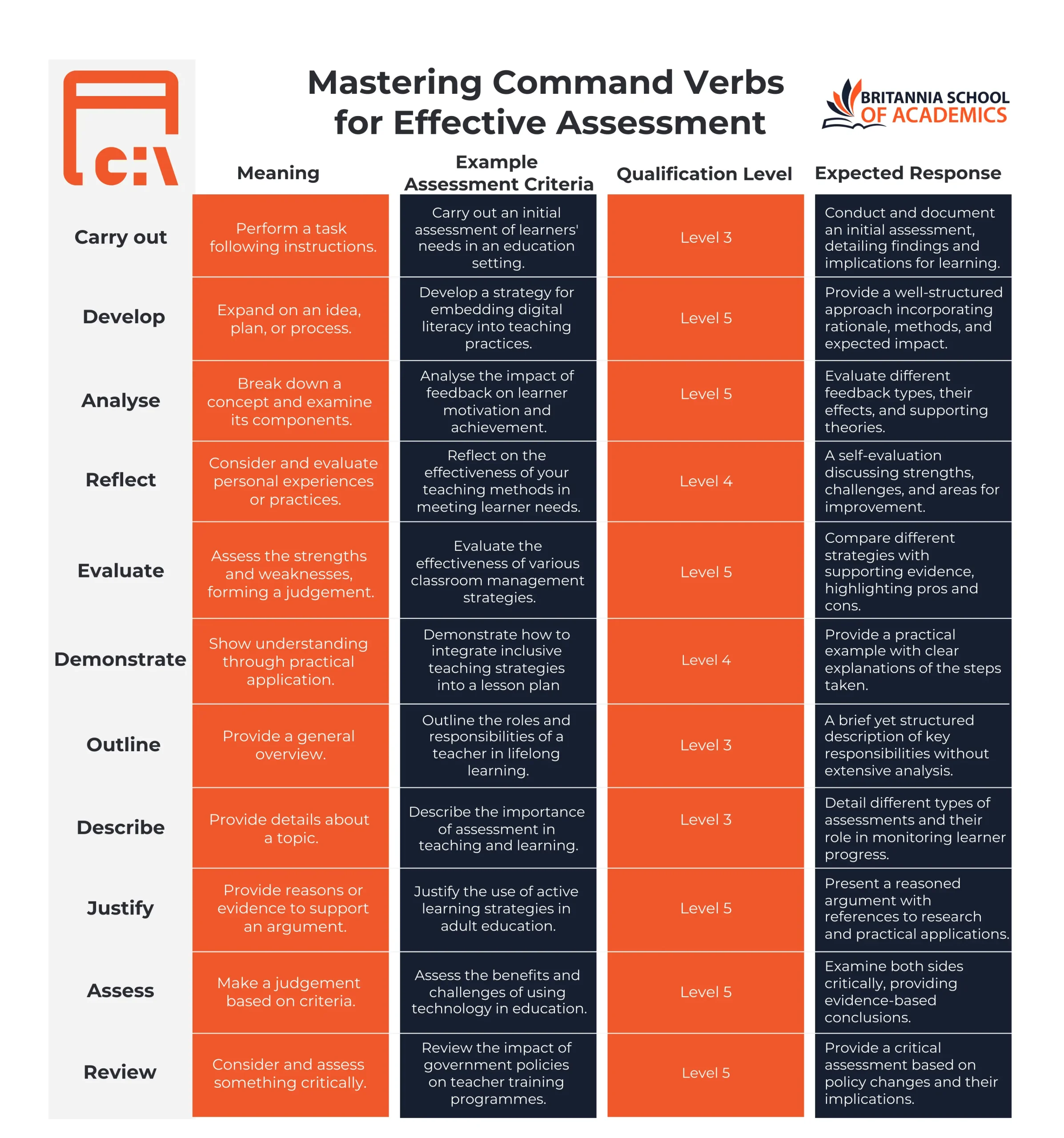Understanding command verbs is essential for learners and assessors to meet the requirement of the assessment criteria. Command verbs help learners understand what is expected in the response/answer of the assessment questions, whether they need to describe, analyse, evaluate, or discuss the topic. For a well-structured and aligned response, understanding these command verbs is crucial.
Key Takeaways
- Understanding command verbs ensures accurate responses and helps learners meet assessment criteria effectively.
- Different qualifications require varying levels of cognitive skills, influencing the choice of command verbs.
- Careful interpretation of command verbs, structured responses, and effective use of assessment rubrics contribute to achieving learning outcomes.
In this blog, we will guide you on how to break down commonly used command verbs that can help both learners and assessors in the navigation of assessment criteria effectively.

Understanding Command Verbs in Assessments
Command verbs are instructional verbs, that are used in the assessment questions to guide learners on how to shape their answers. They play a crucial role in the assessment procedure, exams and competency-based assessments by ensuring students demonstrate their knowledge in a way that aligns with learning objectives.
Command verbs define the depth of understanding and level of critical thinking required. Misinterpreting a command word can lead to an incomplete or incorrect response, even when a learner understands the topic well.
How Different Levels of Learning Influence the Choice of Command Verbs?
Different levels of learning significantly influence the choice of command verbs used in assessment process. While similar command verbs may be used across various qualifications, their expectations differ based on the qualification level, requiring varying depths of knowledge and understanding. These levels are defined by Bloom’s Taxonomy framework that categorises cognitive skills into six hierarchical levels, guiding assessors in selecting appropriate command verbs for assessments
Here’s a list of command verbs according to each Bloom’s Taxonomy Learning Stage;

To ensure consistency in assessments, awarding bodies designate specific command verbs according to the qualification level. For example, a Level 3 qualification does not necessitate in-depth scrutiny and typically employs verbs such as Describe or Explain. Conversely, Level 5 or 7 qualifications require sophisticated cognitive engagement, incorporating command verbs like Critically Evaluate or Justify to assess advanced reasoning, analytical dexterity, and research proficiency.
Common Command Verbs and Their Meanings
Command verbs are classified according to the cognitive demand required at different qualification levels. The depth and complexity of response expected for the same command verb vary depending on the qualification level. For example, at Level 3, Explain may require a straightforward elaboration, whereas at Level 5, it would necessitate a more analytical and comprehensive justification. Below are some common command verbs, their meanings, and examples.

How to Use Command Verbs Effectively?
Correct use of command verbs is essential to respond effectively to meet the requirements of the assessment criteria. Following are a few strategies learners should follow to meet the requirements of assessments.
Read the Question Carefully: Carefully review the assessment criterion, identify the command verb, and ensure you understand what is required. Respond accordingly by aligning your answer with the verb’s expectations. For example, if the criterion asks you to analyse, do not simply describe—break down the topic, examine its key components, and discuss their advantages and limitations.
Structure your Response: Once you have identified the command verb, structure your answer accordingly. Familiarise yourself with the expectations of each verb. For instance, if the criterion requires you to evaluate, you should present both strengths and weaknesses, express a well-reasoned viewpoint, and conclude with a justified judgment.
Check the Assessment Rubric for Guidance: Most awarding bodies provide assessment rubrics that outline how responses should be structured based on command verbs. These rubrics specify the required depth of response and detail the grading criteria. For example, a rubric for justify may require well-supported arguments and evidence to achieve the highest grade. Additionally, tasks that involve identifying or listing key elements can sometimes contribute to higher marks when applied effectively.
Follow Required Cognitive Level: Your response must match the depth of the cognitive level based on the level of qualification you are undertaking.
- Lower-order thinking: Identify, define, describe (basic recall and understanding).
- Mid-level thinking: Explain, apply, compare (demonstrating knowledge in context).
- Higher-order thinking: Analyse, evaluate, justify (critical thinking and argumentation).
Review your Response: After completing your answer, carefully re-read the assessment criterion (AC) to ensure you have correctly interpreted the command verb. Verify that your response fully aligns with the requirements. For example, if the AC asks you to analyse but you only describe the topic without discussing its advantages, challenges, or providing supporting evidence, your response will not meet the expected standard.
Advance Your Educational Journey Today!
Our expert-designed courses equip you with the skills to interpret assessment criteria accurately and respond effectively to achieve the desired outcomes.
Click here to reach out for more information.

Conclusion
Mastering command verbs is essential for learners to meet assessment criteria and achieve higher grades. These instructional verbs define the depth of understanding required in responses. Misinterpreting can lead to incomplete or incorrect answers, even with strong subject knowledge. Different qualifications and awarding bodies use specific command verbs, to ensure uniformity in assessments. Aligning responses with the appropriate cognitive level enhances clarity, relevance, and coherence. Additionally, assessors can ensure fair and consistent grading by evaluating responses based on these verbs. Developing a strong command of assessment language ultimately leads to greater academic achievement and professional success.



